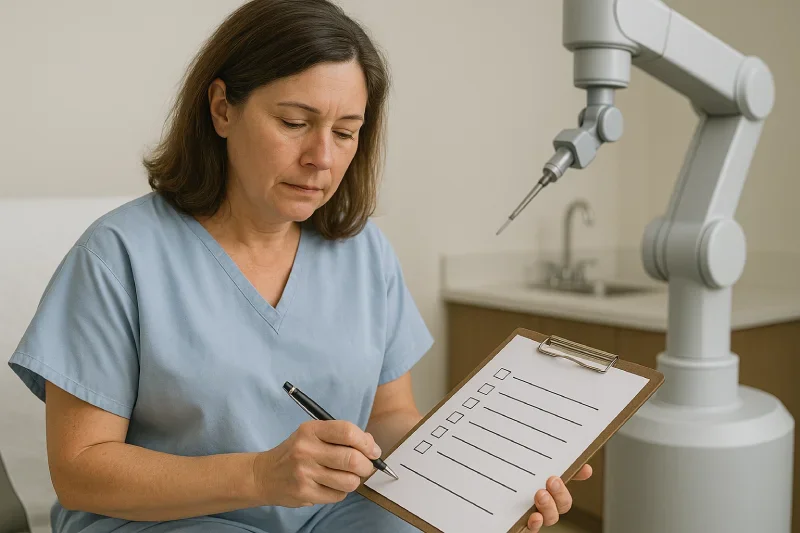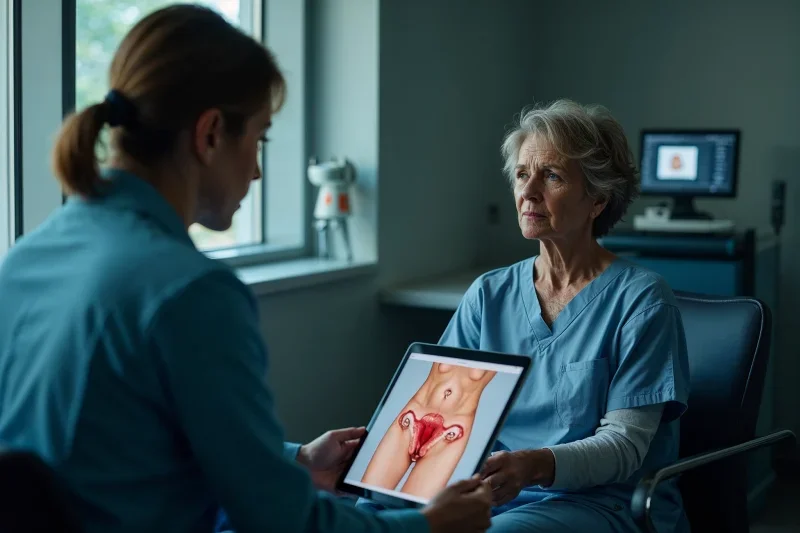The Path to Motherhood: Monitoring Ovulation After Tubal Ligation Reversal
Categories:
By: Ethan Cole
Tubal ligation reversal reconnects the fallopian tubes, restoring fertility and allowing for natural conception.
Monitoring ovulation post-reversal is crucial, with methods including menstrual cycle tracking, basal body temperature, and ovulation predictor kits.
Signs of ovulation include changes in cervical mucus, body temperature shifts, mild pelvic pain, and increased libido.
Ultrasounds and doctor’s guidance are key for interpreting ovulation signs, monitoring ovarian activity, and advising on conception timing.
Irregular cycles and medical conditions like PCOS, thyroid disorders, and endometriosis can affect ovulation, requiring personalized management strategies.
Introduction
Following your tubal ligation reversal, it is crucial to meticulously track your ovulation process in order to enhance your chances of achieving conception. It is advisable to familiarise yourself with the indicators of ovulation, which include clear, elastic cervical mucus, minor fluctuations in body temperature, and slight pelvic discomfort. The utilization of ovulation prediction kits, along with consistent ultrasound examinations, can be instrumental in monitoring your progress. Implementing a well-balanced diet, engaging in regular physical activity, and managing stress levels can serve as effective strategies to augment your fertility. Nonetheless, it is important to note that each woman’s response to the procedure varies considerably, hence the necessity for patience and adherence to a health-conscious lifestyle. As you navigate your path back to motherhood, gaining in-depth knowledge about handling irregular cycles or any potential medical conditions that could affect ovulation may prove to be advantageous.
Understanding Tubal Ligation Reversal
You might be wondering, “What is tubal ligation reversal?” Simply put, it’s a procedure that can restore your fertility after a tubal ligation. We’ll discuss how it works, its success rates, and the factors that can affect its outcomes.
What Is Tubal Ligation Reversal?
Having undergone tubal ligation - a procedure often referred to as “having your tubes tied” - many women believe their decisions about family planning are set in stone. But what if you could revisit those decisions? Tubal ligation reversal can make that possible.
This procedure is designed to restore fertility by reestablishing a clear pathway through your fallopian tubes. It’s a delicate process that requires the expertise of fertility specialists for tubal reversal. These professionals meticulously reconnect the severed parts of the tubes to allow eggs to once again journey towards the uterus.
Success rates for tubal reversal can vary greatly depending on factors like age, overall health, and the original method of tubal ligation. However, many women have successfully conceived after the reversal procedure.
Essentially, the goal of tubal ligation reversal is to give you a second chance at motherhood. It’s not a guarantee, but it’s an option that’s worth considering if you’re contemplating expanding your family. Remember, this is your journey, and being aware of all your options can empower you to make the best decision for your future family planning.
How Tubal Ligation Reversal Restores Fertility
When considering a tubal ligation reversal, it’s vital to understand how this procedure can restore your fertility. Fundamentally, a tubal ligation reversal restores fertility by undoing the previous procedure that blocked or sealed your fallopian tubes, which prevented eggs from reaching the uterus for fertilization.
Here’s how it works: In a tubal ligation reversal, the surgeon reopens, unties, or reconnects your fallopian tubes, thereby allowing eggs to travel down the tubes and into the uterus once again. This restores the possibility of conceiving naturally, without the need for in-vitro fertilization.
Post-tubal reversal fertility tips often include tracking your menstrual cycle and ovulation to maximize your chances of conceiving after tubal ligation reversal. Monitoring your body’s natural signs of fertility—like basal body temperature or cervical mucus—can provide useful information about your fertility status.
It’s important to remember that everyone’s body is different and responds differently to surgical procedures. While one woman may conceive soon after a reversal, another might take longer. Having patience and maintaining a healthy lifestyle can boost your chances of successfully conceiving after a tubal ligation reversal.
Success Rates and Factors Affecting Outcomes
It is crucial to understand that while a tubal ligation reversal can restore your fertility, success isn’t guaranteed for everyone. The success rates and factors affecting outcomes vary considerably from person to person. Ovulation monitoring after reversal is a critical step in evaluating the success of the procedure.
Despite the procedure’s potential, tubal reversal ovulation challenges can hinder your path to conception. These challenges can include factors like scar tissue blocking the tubes or irregular ovulation cycles. Age, overall health, and the type of tubal ligation originally performed also play a major role in the success rates.
You’ll also find that your doctor’s expertise and the surgical techniques used in the reversal will impact your chances of success. It is vital to choose a skilled surgeon with a proven track record in tubal ligation reversal.
The Role of Ovulation in Conception
Understanding why ovulation is essential after reversal surgery is the first step in your journey to conception. It’s important for you to know your menstrual cycle post-reversal, as this can provide vital indicators of ovulation. Let’s explore the signs and symptoms of ovulation, to help you better monitor your fertility.
Why Ovulation Is Critical After Reversal Surgery
Although you might think that having your tubes untied would automatically lead to successful conception, it is crucial to understand the role of ovulation in this process. Ovulation is the release of a mature egg from the ovaries, which if fertilized by a sperm, can lead to pregnancy. Understanding and monitoring your ovulation is critical after a tubal ligation reversal, as this can greatly increase your chances of successful conception.
Now, you may face irregular cycles after tubal surgery, making it a bit challenging to predict your ovulation. This is where ovulation predictor kits for pregnancy come in handy. These kits can help you determine the most fertile days in your cycle, increasing your chances of conception.
Additionally, following preconception tips after tubal ligation can also be beneficial. These tips may include maintaining a healthy diet, regular exercise, and reducing stress levels. Remember, a healthy body can enhance your fertility and increase the chances of successful conception following a tubal ligation reversal.
Understanding Your Menstrual Cycle Post-Reversal
Regularly monitoring your menstrual cycle post-reversal is key in optimizing your chances of conception. Understanding your cycle and recognizing when ovulation occurs will guide your journey to motherhood.
One of the best ways to track ovulation is by monitoring your basal body temperature. A slight rise in temperature typically indicates ovulation, giving you a clear signal of your fertility window. Utilize fertility tracking methods such as charting your temperature daily, and you’ll soon notice a pattern that can help pinpoint your most fertile days.
Additionally, lifestyle changes for post-tubal surgery pregnancy can greatly improve your fertility. That means taking care of your body through a balanced diet, regular exercise, and adequate rest. Minimize stress as much as possible, as it can interfere with ovulation and the menstrual cycle.
Signs and Symptoms of Ovulation
Ever wondered how ovulation plays an essential role in conception? It’s all about timing, and recognizing the signs your body is giving you is vital.
During ovulation, an egg is released from one of your ovaries and travels down the fallopian tube. If sperm is present, fertilization can occur. To enhance fertility naturally, understanding your body’s signs of ovulation is key.
One clear sign is a change in your cervical mucus. As ovulation approaches, cervical mucus becomes clear and stretchy, similar to egg whites, which aids in the transportation of sperm. So, cervical mucus monitoring is an effective, natural method of predicting ovulation.
Other symptoms include a slight drop then a sharp increase in body temperature, heightened senses, light spotting, and mild pelvic pain. You may also notice an increased libido, which nature cleverly uses to increase the chance of conception.
In the journey to motherhood, especially after a tubal ligation reversal, getting in tune with your body’s rhythm can greatly enhance your chances of conception. By recognizing these signs, you’re taking control of your fertility and stepping closer to achieving your dream of becoming a mother.
Monitoring Ovulation After Tubal Ligation Reversal
You’ve undergone a tubal ligation reversal and now you’re keen to conceive. To increase your chances, you’ll need to get a handle on monitoring your ovulation. Let’s explore the methods you can use to track ovulation, and discuss the role of ultrasound and medical guidance in this process.
Methods to Track Ovulation
Many women wonder how to monitor their ovulation after undergoing a tubal ligation reversal. It’s essential to familiarize yourself with the signs of ovulation and various methods to track it.
One common method is observing your menstrual cycle. Ovulation typically occurs about midway through your cycle, usually 12 to 16 days before your next period starts. You can monitor this by tracking the length of your cycles on a calendar or an app.
Another method is tracking your basal body temperature (BBT). Your BBT is your body’s temperature at rest. It rises slightly after ovulation. By taking your temperature every morning before you get out of bed, you can notice a pattern over time and predict when you’ll ovulate.
Checking your cervical mucus is another option. During your cycle, your cervical mucus changes in quantity and texture. Around ovulation, it often becomes clear and stretchy, similar to egg whites, indicating a higher chance of getting pregnant.
Lastly, over-the-counter ovulation predictor kits (OPKs) can be helpful. These tests measure the level of luteinizing hormone, which surges just before ovulation.
The Role of Ultrasound and Medical Guidance
Steering through the world of ovulation tracking after a tubal ligation reversal can be complex, and this is where ultrasound and medical guidance play an essential role. Ultrasound is a non-invasive method that gives a clear picture of what’s happening inside your body. It’s like a window into your reproductive system, allowing you to see when an egg is ready to be released.
Your doctor will guide you through the process, interpreting the ultrasound images and advising the best timing for conception attempts. They’ll look for signs of ovarian activity and follicle development, giving them an accurate estimate of when ovulation is likely to occur. This medical guidance is invaluable, ensuring you’re not left to decipher the signs alone.
But remember, while ultrasound tracking is a powerful tool, it’s not the sole solution. It should be combined with other methods, like tracking your basal body temperature or changes in cervical mucus, for a thorough approach. This might seem like a lot to take in, but don’t fret! With perseverance and the right guidance, you’ll master the art of ovulation tracking, paving the way to a successful pregnancy.
Challenges in Ovulation Monitoring
Monitoring your ovulation after a tubal ligation reversal isn’t always a walk in the park. You might encounter irregular cycles, cope with medical conditions affecting ovulation or even need to consult a fertility specialist. Let’s tackle these challenges one by one to help you navigate this process with less stress.
Irregular Cycles and How to Manage Them
Understanding your menstrual cycle can be a real challenge, particularly after a tubal ligation reversal. Sometimes, you might find your cycles are irregular, which can make tracking ovulation a tricky task. But don’t worry, there are ways to manage this.
Firstly, it’s important to understand what constitutes an ‘irregular’ cycle. Generally, if your cycle length varies by more than a few days each month, it’s considered irregular. This can make predicting your ovulation day difficult, as it may not occur at the same time each cycle.
One effective method to manage irregular cycles is by tracking your basal body temperature (BBT). This involves taking your temperature first thing in the morning before you get out of bed. You’ll notice a slight rise in temperature around ovulation. By charting these temperatures, you can start to identify patterns and predict ovulation, even with irregular cycles.
Stress management and a balanced diet can also help regulate your cycles. Stress can throw off your cycle, while certain nutrients can promote regular ovulation. It’s a journey, but with patience and dedication, you can navigate your path to motherhood.
Medical Conditions That May Affect Ovulation
Several health conditions can create hurdles in accurately monitoring your ovulation, especially after a tubal ligation reversal. Conditions such as polycystic ovary syndrome (PCOS), thyroid disorders, and endometriosis can affect the regularity and predictability of your menstrual cycle.
PCOS is a common condition where small cysts grow on your ovaries, leading to hormonal imbalances. This often results in irregular periods, making it difficult to track your ovulation. Thyroid disorders, either hypothyroidism or hyperthyroidism, can also disrupt your menstrual cycle. Your thyroid regulates your body’s metabolism, so any imbalance can alter your cycle, consequently affecting ovulation.
Endometriosis, a condition where tissue similar to the lining of the uterus grows outside the uterus, can also interfere with ovulation. It can cause painful periods and make it difficult to predict your ovulation.
Understanding these conditions and how they affect your body’s natural rhythms is essential in monitoring your ovulation after a tubal ligation reversal. It’s important to work closely with your healthcare provider to manage these conditions and increase your chances of conceiving. After all, knowledge is power, especially on the path to motherhood.
When to Seek Help From a Fertility Specialist
At times, despite your best efforts, tracking ovulation after tubal ligation reversal can pose significant challenges. You’re charting, testing, and doing everything right, but you’re not seeing the results you expect. That’s when it’s time to reflect on reaching out to a fertility specialist.
A fertility specialist can provide a more in-depth evaluation of your situation and offer personalized advice. They’re equipped with tools and knowledge beyond the basics, capable of identifying underlying issues that may be hindering your ovulation or conception.
If you’ve been trying to conceive for over a year without success, or six months if you’re over 35, seeking help from a specialist is a wise step. Similarly, if you’re experiencing irregular menstrual cycles, severe pain during your periods, or have a known fertility impairment, don’t wait. It’s essential to get professional help sooner rather than later.
Optimizing Fertility After Tubal Ligation Reversal
You’ve navigated the challenges of monitoring ovulation after your tubal ligation reversal, now it’s time to focus on optimizing your fertility. Let’s look at how diet and lifestyle impact your fertility, understand the role stress plays in ovulation, and explore the benefits of supplements and medications. It’s about giving your body the best chance for conception.
Diet and Lifestyle Recommendations
Boosting your fertility after a tubal ligation reversal can be as simple as making significant changes to your diet and lifestyle. Let’s start with your nutritional intake. Prioritize a balanced diet that’s rich in fruits, vegetables, lean proteins, and whole grains. These foods are packed with essential vitamins and minerals that support reproductive health. Specifically, folic acid, iron, and omega-3 fatty acids are important for a healthy pregnancy.
Cut back on processed foods and those high in saturated fats, as they can negatively impact hormone balance and ovulation. Also, consider limiting caffeine and alcohol intake. They’ve been linked to fertility issues in some studies.
Regular exercise is another significant component. It helps maintain a healthy body weight, which is essential for ideal fertility. But, don’t overdo it. Excessive physical stress can disrupt your menstrual cycle. Aim for moderate, consistent activity like brisk walking, biking, or yoga.
The Impact of Stress on Ovulation and Fertility
In the quest for optimizing fertility after tubal ligation reversal, it’s essential not to overlook one significant factor - stress. Chronic stress can impact your ovulation and fertility in several ways. It can disrupt your menstrual cycle, making it harder to predict when you’re ovulating and consequently, when to time intercourse.
Your body’s response to stress involves releasing hormones, such as cortisol, which can interfere with your body’s ability to produce the hormones necessary for ovulation. This can lead to irregular cycles or even anovulation - where no ovulation occurs.
The Role of Supplements and Medications
While managing stress is a significant part of optimizing fertility, another aspect to ponder is the use of supplements and medications. You’ve likely heard about prenatal vitamins, but did you know that some specific supplements can enhance fertility? Folic acid, for instance, is beneficial even before conception, reducing the risk of neural tube defects in the baby. Omega-3 fatty acids, too, can help regulate hormones and promote ovulation.
But it’s not just about supplements. Medications can also play an important role in this journey. Clomiphene Citrate, commonly known as Clomid, is often prescribed to stimulate ovulation. Metformin may be used if you’re dealing with Polycystic Ovary Syndrome (PCOS), a common cause of infertility.
However, remember that this isn’t a one-size-fits-all game. What works for your friend might not work for you. It’s vital to consult with your healthcare provider before starting any new supplement or medication routine. They can guide you based on your unique health history and fertility goals, ensuring that you’re taking the right steps toward motherhood after a tubal ligation reversal.
When Ovulation Monitoring Isn’t Enough
While tracking your ovulation is a vital step after tubal ligation reversal, sometimes it’s not enough. You may need to take into account advanced fertility treatments if you’re not seeing the results you want. Remember, it’s important to balance your expectations and understand that these things can take time.
Advanced Fertility Treatments as Next Steps
Sometimes, despite your best efforts to monitor ovulation after a tubal ligation reversal, getting pregnant naturally doesn’t pan out. When this happens, don’t lose hope. Advanced fertility treatments are the next steps to contemplate.
In Vitro Fertilization (IVF) is an effective method where your eggs are fertilized by sperm outside your body. You might also try Intracytoplasmic Sperm Injection (ICSI), where a single sperm is injected directly into an egg. Both of these treatments bypass the fallopian tubes, making them ideal if your tubal ligation reversal didn’t restore full functionality.
Another option is fertility drugs to stimulate your ovaries to produce multiple eggs. If you’re dealing with ovulation issues, these medications can be a game-changer.
Lastly, contemplate trying Intrauterine Insemination (IUI). It involves placing sperm directly into your uterus during ovulation, increasing the chances of fertilization.
Balancing Expectations and Understanding Timeframes
After exploring advanced fertility treatments, it’s important to balance your expectations and understand that these procedures might take time. It’s not unusual for it to take several months, or even a year, for successful conception after a tubal ligation reversal.
Keep in mind, just because you’re monitoring ovulation and timing intercourse perfectly doesn’t guarantee immediate success. The human reproductive process is complex and influenced by many factors, not all of them within your control. It’s essential to maintain perspective and patience during this journey.
Remember, each woman’s body responds differently to treatments. Factors like age, overall health, and the quality of your partner’s sperm play significant roles. While it’s natural to feel a range of emotions, from excitement to frustration, it’s key to stay positive and grounded.
Don’t be disheartened if pregnancy doesn’t occur immediately. It’s a process, and each step brings you closer to your goal. Seek support from professionals and loved ones, and consider joining a support group. Above all, keep faith in your body and the journey you’re on. Your path to motherhood might be longer than you expected, but it’s a journey worth taking.
Preparing for Pregnancy After Reversal Surgery
Getting ready for pregnancy after a reversal surgery isn’t just about monitoring ovulation. It’s equally important to guarantee you’re in good health before conception, and to manage your emotional well-being throughout the process. Don’t forget, supporting your partner during this journey is a crucial part of preparing too.
Preconception Health Check
Undergoing a tubal ligation reversal is just the first step in your journey to conceive again. It’s crucial to verify your body is ready for pregnancy, and a preconception health check is a critical part of this process. This involves a thorough evaluation of your health to identify and address any potential risks before you conceive.
A preconception health check typically includes a detailed medical history review, physical examination, and necessary laboratory tests. You’ll need to share your entire health history, including previous pregnancies, surgeries, and any chronic conditions like diabetes or high blood pressure. It’s also important to discuss lifestyle habits, such as diet, exercise, smoking, and alcohol use.
You may also need to undergo genetic screening. This can help identify potential genetic disorders that could impact your future child’s health. In addition, it’s crucial to be up-to-date with vaccinations, as certain diseases can affect pregnancy outcomes.
Lastly, maintaining a healthy weight can improve your chances of getting pregnant and having a healthy pregnancy. If your weight is an issue, your healthcare provider can provide guidance on achieving a healthier BMI.
Managing Emotional Well-Being
In spite of the physical changes and challenges, preparing for pregnancy after reversal surgery also involves managing your emotional well-being. You may experience a range of emotions, from excitement and anticipation to worry and anxiety. It’s absolutely normal and okay to feel this way.
Remember, your emotional health is as important as your physical health in this journey. Embrace your feelings and find healthy ways to express them. You might find journaling your thoughts, practicing mindfulness, or engaging in relaxing activities like yoga or meditation helpful.
Don’t hesitate to seek professional help if you think you’re struggling with your emotions. A mental health professional can provide you the tools to cope with stress, anxiety or any other emotional difficulties you may be experiencing.
Supporting Your Partner During the Journey
Steering the path toward pregnancy after a tubal ligation reversal can be a rollercoaster of emotions not just for you, but for your partner as well. It’s essential to remember that you’re not alone on this journey - your partner’s support is invaluable. And just as you need their support, they need yours too.
Communication is key. Openly discuss your fears, hopes, and expectations. It’s okay to express your worries about the procedure, fertility, and the possibility of pregnancy. At the same time, reassure your partner that their feelings are equally important. Encourage them to share, and be a good listener.
Another thing you can do is to make lifestyle changes together. Eating healthier, exercising, and reducing stress levels can increase your chances of conception. It’s easier when you’re both committed.
Lastly, keep your relationship strong. This journey can put a strain on even the most solid relationships. Regular date nights, small surprises, or simply spending quality time together can help keep the spark alive. You’re in this journey together - supporting each other will make it easier, and that much more meaningful.
Conclusion
After exploring the complexities of monitoring ovulation post-tubal ligation reversal, you’ve likely gained a deeper understanding of this intricate process. It’s not a path for the faint-hearted, but your determination and quest for knowledge can empower you to take control of your fertility journey.
Understanding your body’s signals and utilizing fertility tracking tools are essential steps in this process. You’ve learned how to track your menstrual cycle, monitor basal body temperature, and use ovulation predictor kits effectively. Remember, consistency is key in all these methods.
But this journey isn’t just about gaining technical knowledge. It’s about embracing the possibility of motherhood, and the personal growth that comes along with it. It’s about patience, resilience, and the strength to keep moving forward, even when the path seems unclear.
While the journey to motherhood post-tubal ligation reversal can be challenging, it’s also filled with incredible potential. Every step you take brings you closer to your goal. Stay informed, stay empowered, and remember—your path to motherhood is as unique as you are. This is Dr. Jason Neef, and it’s my honor to be part of your journey toward achieving your dreams of motherhood.
Call now to schedule an appointment with Dr. Jason Neef and explore your fertility options.
Call (817) 568-8731Categories:
Frequently Asked Questions
-
Yes, it is possible to become pregnant following a tubal reversal surgery, depending on factors like egg quality, the amount of damage to the fallopian tubes, and your overall health. Consulting a fertility center can provide tailored advice.
-
The risk of ectopic pregnancy is a concern following tubal reversal. This occurs when the embryo implants outside the uterine cavity, typically in the fallopian tubes. Regular monitoring and early detection are crucial to ensure safety.
-
Most doctors recommend waiting 2-3 months following tubal reversal surgery before you start trying to conceive. This allows the surgical site to heal properly, reducing risks and complications and increasing the chance of becoming pregnant.
-
While Essure removal can alleviate symptoms caused by the implant, it does not always restore natural fertility. For women wanting to get pregnant after tubal sterilization, options like assisted reproductive technologies may be necessary.
-
Tubal reversal surgery typically requires general anesthesia to ensure the patient is asleep and comfortable. This type of ligation reversal is a minimally invasive outpatient procedure that often involves small incisions.
-
After the procedure, patients should keep the incision site clean and dry to prevent infection. Avoid strenuous activities for a few weeks and follow your doctor’s recommendations for a safe recovery. Recovery time may vary per individual.
-
Natural contraceptive methods, like tracking ovulation, can help prevent pregnancy, but they are less reliable than other forms of contraception. Consult with a center for fertility and gynecology to explore your options.
-
While it is still possible to achieve a successful pregnancy following a tubal ligation reversal, the risk of ectopic pregnancy remains higher compared to natural conception. Speak with your fertility center about monitoring during early pregnancy.
-
The success rate of the tubal reversal procedure depends on the type of ligation performed. For instance, tubal rings or clips cause less tubal damage, increasing the likelihood of being able to conceive after surgery.
-
If natural conception is not possible, assisted reproductive technologies like IVF are viable options. A fertility center in your area, such as the Thousand Oaks office or a specialist in gynecology in Los Angeles, can guide you through these alternatives.











